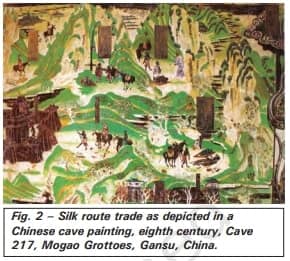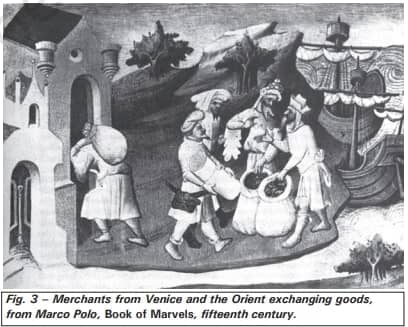The Pre-modern World Concept & Notes PDF for Free
Topic & sub-topics covered: The Pre-modern World, Silk Routes Link the World, Food Travels: Spaghetti and Potato, Conquest, Disease and Trade: The Making of a Global World (All single detail notes that are exam-oriented).
We have discussed in-depth and exam-oriented pointers that can be asked in the board exam of class 10th about “The Pre-modern World, Silk Routes Link the World, Food Travels: Spaghetti and Potato, Conquest, Disease and Trade” which is taken from the NCERT History book for class 10th chapter no. 3 “The Making of a Global World“.
Download NCERT History Chapter 3 Class 10th Notes PDF for Free The Making of a Global World
If you are in class 10th and looking for free NCERT History chapter 3 notes of chapter The Making of a Global World class 10 that cover concepts, then From here you can download the free class 10th History chapter 3 notes “The Making of a Global World”. You should download this free PDF for future test or exam preparations.
NCERT History Chapter 3 The Making of Global World Class 10 Notes
The Pre-modern World

1. Concept of Globalisation:
- Globalisation is often associated with an economic system that has developed in the last 50 years.
- However, the chapter emphasizes that the making of the global world has a much longer history.
2. Historical Phases of Globalisation:
- The emergence of the global world involves a historical process comprising trade, migration, labour movements, capital flow, and more.
- Understanding the historical phases is crucial for comprehending contemporary interconnectedness.
3. Diverse Aspects of Global Interconnectedness:
- Globalisation involves various dimensions such as trade, migration, work-seeking journeys, capital movement, and more.
- The interconnectedness of societies is a multifaceted phenomenon with roots in ancient times.
4. Historical Movement of People:
- Throughout history, individuals like travellers, traders, priests, and pilgrims covered vast distances for various purposes.
- This movement facilitated the exchange of goods, money, values, skills, ideas, inventions, and even diseases.
5. Early Instances of Global Trade:
- As early as 3000 BCE, an active coastal trade connected the Indus Valley civilizations with West Asia.
- Cowries, used as a form of currency, travelled from the Maldives to China and East Africa for more than a millennia.
6. Long-Distance Disease Spread:
- The spread of disease-carrying germs across long distances dates back to at least the seventh century.
- By the thirteenth century, this phenomenon had become a recognizable and significant aspect of global connectivity.
Silk Routes Link the World

1. Silk Routes as Pre-Modern Trade Network:
- The silk routes exemplify a dynamic pre-modern trade and cultural network connecting distant regions.
- West-bound Chinese silk cargoes were particularly significant along these routes.
2. Variety of Silk Routes:
- Historians have identified multiple silk routes, encompassing both overland and maritime routes.
- These routes interconnected vast regions of Asia and linked Asia with Europe and northern Africa.
3. Longevity of Silk Routes:
- Silk routes have a long history, existing since before the Christian Era and thriving until the fifteenth century.
- They facilitated the exchange of goods and ideas across diverse cultures and civilizations.
4. Diverse Goods Traded:
- While Chinese silk was a major commodity, other goods like Chinese pottery, textiles, and spices from India and Southeast Asia were also traded.
- Precious metals, specifically gold and silver, flowed from Europe to Asia in return.
5. Trade-Culture Nexus:
- Trade and cultural exchange were inseparable along the Silk Routes.
- Early Christian missionaries and Muslim preachers are believed to have traversed these routes, showcasing the intersection of religious propagation and trade.
6. Role of Silk Routes in Buddhism Spread:
- Buddhism, originating in eastern India, spread to various directions through intersecting points on the silk routes.
- The silk routes played a crucial role in the dissemination of religious and cultural influences.
Food Travels: Spaghetti and Potato

1. Long-Distance Cultural Exchange Through Food:
- Food serves as a compelling example of cultural exchange over long distances.
- Traders and travellers played a crucial role in introducing new crops to the regions they traversed.
2. Spaghetti and Noodles as Cultural Artifacts:
- Spaghetti and noodles exemplify how food items might share common origins but evolve differently in different parts of the world.
- The journey of noodles from China to becoming spaghetti in the West or the possible role of Arab traders in taking pasta to Sicily demonstrates the complex history of food exchange.
3. Uncertainty in Food Origins:
- The true origins of certain foods like spaghetti/noodles remain uncertain due to the complexities of historical interactions.
- Similar foods were known in diverse regions such as India and Japan, highlighting the challenges in determining precise food origins.
4. Introduction of New Foods to Europe and Asia:
- Common foods like potatoes, soya, groundnuts, maize, tomatoes, chillies, and sweet potatoes were unknown to ancestors until around five centuries ago.
- Christopher Columbus’s accidental discovery of the Americas played a pivotal role in introducing these foods to Europe and Asia.
5. Impact of New Crops on Lives:
- The introduction of new crops, like the humble potato, had transformative effects on societies.
- The potato significantly improved the diet and life expectancy in Europe, particularly benefitting the poor.
6. Potato Famine in Ireland:
- The potato became a staple for Ireland’s poorest peasants, and the crop’s destruction in the mid-1840s led to a devastating famine.
- Hundreds of thousands died of starvation, underlining the critical role of certain food crops in sustaining populations.
Conquest, Disease and Trade
1. Impact of European Exploration in the Sixteenth Century:
- European sailors’ discovery of sea routes to Asia and America significantly reduced the pre-modern world’s size.
- The Indian Ocean played a crucial role in global trade with diverse goods, people, knowledge, and customs.
2. Transformation due to America’s Integration:
- America, previously isolated for millions of years, became interconnected globally in the sixteenth century.
- Vast lands, abundant crops, and minerals in America transformed global trade and societies.
3. Role of Precious Metals in Financing Trade:
- Silver, particularly from mines in Peru and Mexico, enhanced Europe’s wealth and financed trade with Asia.
- Seventeenth-century legends in Europe fueled expeditions in search of South America’s fabled wealth, including El Dorado.
4. Impact of European Conquest in America:
- Portuguese and Spanish conquest and colonization of America began decisively in the mid-sixteenth century.
- Conquest was not solely due to superior firepower but also the introduction of germs like smallpox that America’s inhabitants lacked immunity against.
5. Devastating Role of Smallpox:
- Smallpox, introduced by Europeans, proved a deadly killer, spreading ahead of European invaders and decimating whole communities.
- Unlike guns, diseases like smallpox were not easily counteracted, as conquerors were mostly immune.
6. Migration Trends to America:
- Until the nineteenth century, Europe faced common challenges of poverty, hunger, crowded cities, and religious conflicts.
- Thousands fled Europe for America, and by the eighteenth century, plantations with African slaves grew cotton and sugar for European markets.
7. Shift in World Trade Dynamics:
- Until the fifteenth century, China and India were among the world’s richest countries and dominated Asian trade.
- From the fifteenth century, China retreated into isolation, reducing its role, while the Americas’ rising importance shifted the centre of world trade westwards, with Europe emerging as the new centre.
Next & Previous Topics of NCERT/CBSE History Class 10 Chapter 3: The Making of a Global World
| Topics No. | Topics Name |
|---|---|
| 1 | The Pre-modern World |
| 2 | The Nineteenth Century (1815-1914) |
| 3 | The Inter-war Economy |
| 4 | Rebuilding a World Economy: The Post-war Era |

